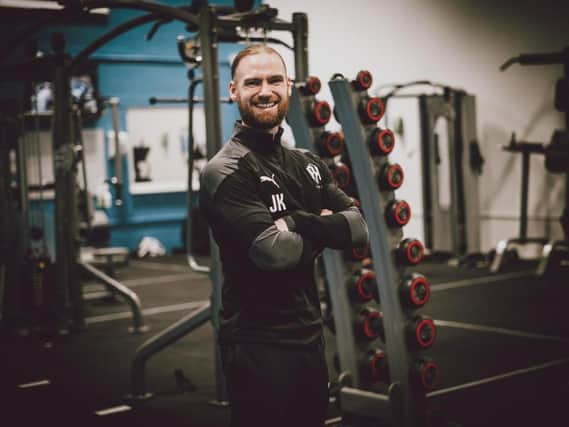Getting back in the gym | Josh Kennedy


We’re all excited to get back in, but after a long break from training, your body will need some time to readjust to the gym work.
Here’s why that’s so important, and how to get the most out of your first month back in the gym!
Injury risk and Covid considerations
Advertisement
Hide AdAdvertisement
Hide AdBefore you get back in the gym at 100mph, let’s start with these two key points on safety. First off, injury risk.
Your body has now experienced maladaptation from not having the same level of stimulus as before- simply put, you’re less prepared to be in the gym lifting weights. Even if you’ve been diligent with home workouts and other forms of exercise throughout the lockdown, you’ll still need to consider this, as the new stimulus of lifting external load, or new movements from the gym machines will take their toll.
If you ignore this, you’re risking injuries holding you back.
The best way to deal with this change in readiness to train is to start steady, and build back up to previous levels of training (and beyond) over the initial weeks. We’ll discuss how to do this (and why) in the next section, but before that, there’s another safety consideration to be aware of Covid guidelines.
Advertisement
Hide AdAdvertisement
Hide AdIt’s important to remember that although gyms are open again, Covid is still very much a big consideration, and the best gyms will be doing everything they can to keep every member safe. This means they will have new Covid guidelines that you may not be used to, for example additional cleaning, handwashing, booking systems and restricted services.
Please ensure you’re familiar with the suggestions made by your gym, and do everything possible to stick to them on every visit. This way, you’ll protect yourself, your coach, your community, and your gym.
Get more out of starting steady
I know you’re raring to go, but in addition to the reduced risk of injury, there’s another reason why doing less initially may be the best approach. You’ll get better results!
If you’ve not been training in the same manner as you will be when you’re back in the gym, you’re probably able to get maximum results with less work.
Advertisement
Hide AdAdvertisement
Hide AdWhen it comes to strength and fitness, more does not mean better. Once we reach a point of maximum stimulus from a workout, doing more builds more fatigue, and adds recovery demands and risks, but doesn’t lead to more results.
In fact, pushing too far beyond this this can actually make the results worse long term, due to accumulating injuries and fatigue impacting your training sessions.
Having a clear plan is a great way to get back to your best (and beyond), but don’t go all out straight away, particularly with lifting. Initially, you may find that 2-3 rounds of exercise at moderate weight get you the benefits without the recovery demands, instead of the 4-5 that you did pre lockdown.
In addition, what used to be 5 days in the gym, may be best starting with 3, then 4, then back to 5. For the initial weeks, enjoy the workouts, but start light, and build to heavier work over a few weeks. Focus on movement and recovery as well as the working sets.
Advertisement
Hide AdAdvertisement
Hide AdLeave a lot in the tank in week 1, particularly in the first couple of sessions, as that fatigue will quickly accumulate and cause problems if you over do it.
Remember, after a long break, a steady start leads to the same results short term as going all in, but with less fatigue, meaning less risk, less pain, and more longevity, ultimately leading to better results in the long run.
Monitor and adjust
Now obviously you may not get this perfect in week 1. You may feel the week was too easy, or you may do too much, and be sore for days. The key here is to monitor how you’re feeling, and make the adjustments needed.
If you’re sore for days after a workout, and this impacts your next planned session, the previous workout was simply more than you’re ready for at the minute (or the balance of the plan isn’t right).
Advertisement
Hide AdAdvertisement
Hide AdIf you feel like you’ve not had a workout, you may need to do a little more, remember, the working sets should still be challenging (but not maximum effort initially), but we can do more weight, more reps, more sets, or more exercises as we build.
As always, I’d suggest working with a coach throughout this complex phase, but if you’re just looking for some basic advice, feel free to send any questions over to me via email: [email protected].
Here’s the point
Right now, you don’t need to push to your limits in the gym. You need to build a tolerance back up.
Over the coming weeks, you can either gradually build back to previous levels, get results faster than ever before, and be in a great place to make even more progress 3-4 weeks down the line, or you can go all in from day 1, and try to pick up where you left off months (if not a year) ago.
Advertisement
Hide AdAdvertisement
Hide AdThe latter approach is risking injury, getting no additional benefits and building up high amounts of fatigue, meaning even if you do stay injury free, results slow down and you’re forced to rest in a couple of weeks.
To me, it’s an obvious choice, and an approach we will be encouraging everyone to take at FX. Start steady, progress quickly, and get maximum results.
Comment Guidelines
National World encourages reader discussion on our stories. User feedback, insights and back-and-forth exchanges add a rich layer of context to reporting. Please review our Community Guidelines before commenting.